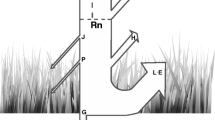Abstract
A physically-based solar radiation transmission model and a slope energy budget model were available which used climatic observations, averaged over 10-deg north-south latitude bands. This made possible the systematic examination of the diurnally changing energy budget components of net radiation, conduction, sensible, and latent heat flux occurring at all slope angles (0 to 90 deg) and slope directions (south-, west-, and north-facing). The present analysis utilized two contrasting landscapes along a latitudinal transect of the east coast of the Americas (northern hemisphere). Among the results, the maximum net radiation for all slope angles and directions occurred at noon on a 40-deg, south-facing slope for latitude 60. Generally, latent and sensible heat fluxes were similar in trend and magnitude between latitudes 0 and 35. Poleward, sensible heat flux increased with advancing latitude at the expense of latent heat flux. A great diversity in net radiation, sensible, and latent heat flux was obtained between different slopes and their orientation at a paniculate latitude. In addition to hourly rates of the energy budget components, daily positive sums of net radiation, sensible, and latent heat flux were examined. It is assumed that the portrayed patterns are general enough to add to our increasing understanding of the contrasts possible in a real-world north-south transect.
Similar content being viewed by others
References
Atwater, N. M. and Ball, J. T.: 1978, ‘A Numerical Solar Radiation Model Based on Standard Meteorological Observations’, Solar Energy 21, 163–170.
Atwater, M. A. and Ball, J. T.: 1979, ‘Erratum’, Solar Energy 23, 275.
Atwater, M. A. and Brown, P. S.: 1974, ‘Numerical Computations of the Latitudinal Variation of Solar Radiation for an Atmosphere of Varying Opacity’, J. Appl. Meteorol. 13, 289–297.
Atwater, M. A. and Lunde, P. J.: 1979, ‘A Cloud-Cover Radiation Model Producing Results Equivalent to Measured Radiation Data’, in 1979 International Congress of the International Solar Energy Society, Atlanta, GA.
Kondratyev, K. Ya.: 1977, Radiation Regime of Inclined Surfaces, Technical Note No. 152, World Meteorological Organization, Geneva.
Meteorological Office: 1961–63, Tables of Temperature, Relative Humidity and Precipitation for the World, Her Majestys Stationery Office, London.
Terjung, W. H. and Louie, S. S.-P.: 1974, ‘A Climatic Model of Urban Energy Budgets’, Geog. Analysis 6, 341–367.
Terjung, W. H. and O'Rourke, P. A.: 1980, Energy Exchanges in Urban Landscapes: Selected Climatic Models, Publications in Climatology, XXXIII, C. W. Thornthwaite Associated and Center for Climatic Research, Elmer, N. J. and Newark, Del.
Terjung, W. H. and O'Rourke, P. A.: 1980b, ‘Simulating the Causal Elements of Urban Heat Islands’, Boundary-Layer Meteorol. 19, 93–118.
Terjung, W. H. and O'Rourke, P. A.:1982a, ‘The Relative Effect of Solar Altitude on Surface Temperatures and Energy Budget Components on Two Contrasting Landscapes’, Boundary-Layer Meteorol. 24, 67–76.
Terjung, W. H. and O'Rourke, P. A.: 1982b, ‘A Worldwide Examination of Solar Beam-Slope Angle Values’, Solar Energy (in press).
Terjung, W. H. and O'Rourke, P. A.: 1982c, ‘The Effects of Changing Solar Angles, Cloud Regimes, and Air Temperatures of Contrasting Surfaces’, Boundary-Layer Meteorol. 24, 269–279.
Terjung, W. H. and O'Rourke, P. A.: 1982d, ‘Energy Budget Changes Caused by Varying Solar Angles, Cloud Scenarios, and Air Temperatures in Contrasting Landscapes’, Int. J. Biometeor. 27, 3–16.
Terjung, W. H. and O'Rourke, P. A.: 1982e, ‘A Simulation of Surface Temperatures for a North-South Latitudinal Transect During the Winter Solstice’, Arch. Meteorol., Geophys. Bioclimatol. 32, 59–76.
Terjung, W. H. and O'Rourke, P. A.: 1982f, ‘Simulating Midday All-Slope Surface Temperatures Along a Climatic-Latitudinal Transect During Cloudless Summer Conditions’, Boundary-Layer Meteorol. 24, 481–493.
Author information
Authors and Affiliations
Additional information
Dr O'Rourke is currently a visiting Scholar at UCLA for Litton Systems, Inc., Data Systems Division.
Rights and permissions
About this article
Cite this article
Terjung, W.H., O'Rourke, P.A. An all-slope 24-hour summer energy budget regime along a climatic-latitudinal transect. Boundary-Layer Meteorol 26, 227–242 (1983). https://doi.org/10.1007/BF00121400
Accepted:
Issue Date:
DOI: https://doi.org/10.1007/BF00121400




